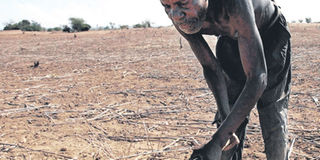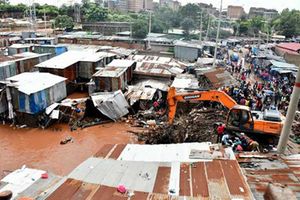Hunger, heat, flooding: No, this is not a passing cloud

Climate change is rarely an interesting subject in these parts of the world, but scientists are warning that it is time you sat up and listened.
What you need to know:
- Climate change is rarely an interesting subject in these parts of the world, but scientists are warning that it is time you sat up and listened.
- For a country that has always been grappling with food security, it was astounding that not many people found the story as interesting as those about the country’s political shenanigans.
- In the Horn of Africa, for instance, drought has been a recurrent problem of late.
Towards the end of last month, a rather alarming story appeared in this newspaper, warning that the country was headed for a major food crisis following depressed rainfall in the North Rift.
Surprisingly, it did not receive much attention on our online platforms compared to other stories of the week, and only one person had commented on it by last Sunday.
The story reported that agriculture experts and farmers had expressed fears that they would have a poor maize harvest this year after more than 40 per cent of the crop was damaged by drought.
Uasin Gishu County, the region regarded as Kenya’s bread basket, produced 4.5 million bags of maize last season but the yield is set to drop after the crop was destroyed by the dry spell.
As a result of the poor rainfall, some farmers reduced the acreage under crop production here to about 77,225 hectares of the targeted 92,500.
For a country that has always been grappling with food security, it was astounding that not many people found the story as interesting as those about the country’s political shenanigans.
That disinterested approach to such stories explains why few people are worried about the future of Kenya’s food reserves, or whether Uasin Gishu is sending a warning that things are about to get tight for the nation’s 40-million-plus mouths.
Many think this is just a passing cloud, that the country will be back on its feet soon.
That may happen, but the signs of the times are warning you to prepare for the worst; at least for the next 20 years.
In Germany, a group of scientists have even more depressing news for Kenya and the region: they have identified the “hotspots of climate change in Africa”, and Kenya is among a number of countries that will suffer multiple climatic problems in the next two decades.
The scientists, from the Potsdam Institute for Climate Impact Research (PIK), warn that the three regions expected to be among those most at risk in a couple of decades are parts of Sudan and Ethiopia, the countries around Lake Victoria, and the continent’s south-eastern corner, especially parts of South Africa, Mozambique and Zimbabwe.
“These regions are expected to see more severe dry seasons and reduced plant growth, with flooding in Lake Victoria,” they say, adding that Africa has had an above-average climate change and the largest share in poor and undernourished people.
Change factors
“Science and policy need to propose ways of preparing these areas for development under climate change,” note the scientists in a paper titled Hotspots of Climate Change Impacts in Sub-Saharan Africa and Implications for Adaptation and Development, published last month in Global Change Biology.
Lead author Christopher Muller says that what creates “hotspots of risks” are the overlapping impacts of climate change, including drought, floods, declining crop yields or ecosystem damage.
Other climate change properties relevant to Africa and used by the researchers to identify the hotspots include dry periods, total surface fresh water availability, water requirements for crop irrigation and ecosystem productivity.
According to their projections, all of Sub-Saharan Africa runs some risks of being negatively affected by climate change, and an increase in flooding is generally much higher in Tanzania, Uganda and southern Ethiopia, where most climate scenarios project increasing rainfall.
The probability of increase in dry periods is generally high in Sub-Saharan Africa and likely to be more pronounced in Ethiopia, Sudan and Eritrea, “which implies that irrigation could at least prolong the cropping period in semi-arid regions”.
Sudan and Ethiopia, the researchers indicate, are home to high-risk populations mostly constituting of poor people who are directly affected by the climate change impacts. Consequently, “these regions are not only hotspots of biophysical perspective, but also from the social-economic perspective”.
The scientists concur that there will be uncertainties in assessing climate change impact, but advise that this can inform development strategies, allowing an assessment of the impact’s potential severity and a choice of ways to adapt.
Edward Mungai, the CEO at Climate Innovation Centre, agrees that Kenya is as exposed to climate change just as any other country in the world.
But, Mungai notes, there are efforts to mitigate its effects as the government has drawn up a progressive climate change document — the National Climate Change Action Plan (NCCAP) — that lays down strategies to combat the phenomenon.
On the ground, however, farmers know little about climate change.
In Subukia and Bahati constituencies of Nakuru County, for instance, most of those we talked to said they had noticed reduced crop yields, but had done nothing to change their farming strategies.
And that, for Kenya, is where the problem lies.
Stephen Mwangi, a farmer here, told us he did not know much about the change of climate as he only hears about it occasionally on radio and television, but agreed that in the last few years, he had witnessed extreme climatic events like abnormal heavy rains that either fell for a long or short time, doing more harm than good to his crop.
Samwel Kariuki, a maize and wheat farmer here, also agreed that something had changed.
“Last year we had very heavy long rains but this year we have gone through a long dry spell,” he explains.
“You cannot be sure whether the rains would be enought for your crop anymore.”
Speaking recently during the launch of climate change adaptation projects in Isiolo County, Victor Oridi, the climate change adviser at the National Drought Management Authority (NDMA), said that communities in the most vulnerable areas needed to be empowered to adapt to the impacts.
“Resources should now be devolved to these areas, especially the arid and semi-arid regions, where customised climate change projects need to be set up and the people involved in their planning and implementation,” said Oridi.
A 2013 UN report titled Africa’s Adaptation Gap: Climate Change Impacts, Adaptation Challenges and Costs for Africa warned that Africa was a “vulnerability hotspot”, and that the impacts would be felt mostly by the continent’s vulnerable and poor populations.
The Kenya National Climate Change Action Plan encourages people-centred development, ensuring that climate change actions help the country achieve its long-term goals.
The action plan estimates that Kenya will require a total of Sh1 trillion ($12.76 billion) by 2017 to adapt to change impacts and implement low carbon development options.
However, Kenya relies on donor countries to fund its adaptation programmes and projects, and the funding is mostly unpredictable, volatile and inadequate.
A June 2013 World Bank report titled Turn Down the Heat: Climate Extremes, Regional Impacts and the Case for Resilience found out that Africa’s 800 million people could hit the 1.5 billion mark by 2050.
That growing population faces multiple climatic risks that could have far-reaching repercussions, largely due to dependence on agriculture as the main source of food and employment.
In the Horn of Africa, for instance, drought has been a recurrent problem of late.




